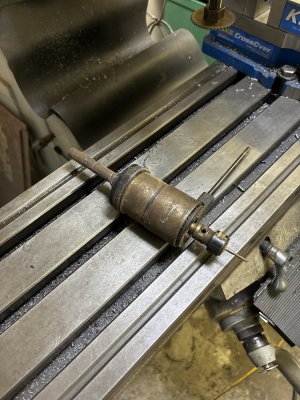- Joined
- Dec 24, 2020
- Messages
- 1,213
I've got a mixed bag of all sorts of taps right now. I'm buying quality taps as different projects come up and getting into more spiral flute and spiral point now that I'm mostly power tapping. I have plug, taper and bottoming taps, along with a few forming taps in most of the common sizes already for manually tapping.What style taps are you using? How often do you find hard spots in the material you are using?
I have been using a solid ER holder on my drill press (with the reversing function described earlier), works great. A nice feature is that it is pretty short, minimizes overhang and doesn’t use up much head room (nice if you don’t have to move the table between drilling and tapping).
As far as random hard spots, in the majority of materials (mild steel, CrMo, aluminum, stainless) I can’t say I have ever encountered any “hard spots” - I have cut a lot of metal. Sure, some cast irons, hard surfaces or work hardening material will be hard (but that is a known thing and you can manage it).
Recommend you get the collet chuck, quality taps for power tapping, and a couple tap collets for the sizes you most commonly encounter (note the attached picture is misleading, to have a typical hand tap - straight flute - showing a tool used in power tapping). I think you can even get collets that incorporate an overload feature (though I have never used them). Using a sharp tap of the correct style, in a correct size & deapth of hole, properly lined up, suitably lubed and the chips managed is very, very unlikely to need an over torque feature. And you get really pretty threads.
If you follow a good procedure for tapping, that tool you mentioned won’t give better results. If you don’t follow a good procedure, that tool won’t turn a poor procedure into great results.

I must have bad luck as I've run into two possible hard spots in the past week or ten days which is what started me back looking at better options than the drill chuck and collets. One was a part I was making out of mystery steel and things were going fine for a while. It was maybe a 1.25" deep hole, 7/16-20 tap and I was at least half way down the bore (a through hole that was definitely drilled the correct size) the tap slipped, started again and broke before I could flip stop it. I guess it's possible the chuck wasn't tight enough and if it hadn't slipped it would have powered through or the other way around where it was too tight and didn't slip soon enough. Either way, it was pretty odd to have it rolling along just fine and then run into trouble.
The second was cast iron where the tap simply didn't want to start...it went maybe a turn and slipped. I tried a second time thinking maybe I didn't give it enough down pressure to get an initial bite and the same thing happened. I was doing a bolt pattern on a super spacer so I went to the next hole and it was fine, as were the next two, so it wasn't the tap. I had to go back to #1, do it manually, and got through it, but that's the sort of stuff I'd like to avoid...it could have ruined the part which was a brand new D1-6 adapter plate, so not cheap. Making it worse, I wouldn't have likely been able to rotate the plate a bit and start a new set of holes so it would have been scrap. It's for a beautiful older 10" Kalamazoo brand chuck with a smaller bolt spacing that barely fits on a D1-6 plate and you really have to dodge the existing holes.
Doing quick math and sticking to something along Shar's pricing, an ER32 holder and a set of ERTC tap holders would be more expensive than the CME tool I linked above. I'm not counting pennies, just pointing out neither one is significantly more/less expensive than the other.
Flexibility of other uses (i.e. regular collets with end mills) where the rubber meets the road is whether an ER setup with ERTC collets would work the same, better or worse than the CME style tool for tapping?


